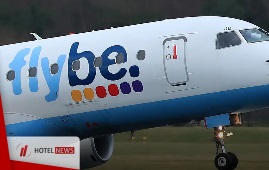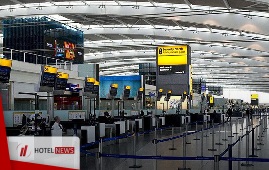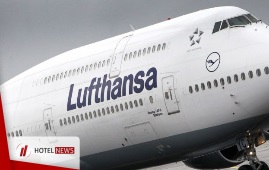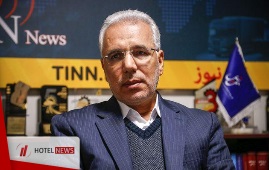
The Check-In Experience Technique 45 Use Strong Verbal Greetings at Check-In; A front desk associate should never address a guest with the phrase ‘checking in?’ Such a greeting does not engender a spirit of hospitality. Would an initial greeting to a visiting friend at your home be ‘staying with me?’ Technique 46 Eliminate the View of Employee Trashcans; A trashcan does not engender a sense of hospitality. Trash- cans used behind the front desk should be positioned so that guests cannot see them. Technique 47 Offer Infused Water at Check-In; During prime check-in hours, keep a beverage dispenser of infused water in the lobby area. Guests can be instructed to help themselves to the water that can be infused with flavors such as strawberry or cucumber. Technique 48 Dispense Information on Tour Bus; If your hotel has tour buses staying at the hotel, have a representative get on the bus before the guests disembark. The hotel representative will have an opportunity to welcome the guests to the hotel, explain outlet hours, and any perti- nent information regarding their stay. If they have to wait in line to give a credit card, they can be instructed at this time. Once they enter the hotel you will lose the “togetherness” of the group. Technique 49 Designate a Children’s Check-In Spot; If a significant number of family check-ins are expected on a given day, designate a spot at the front desk with a sign reading ‘children’s check-in’ and place a step-stool at the spot so that children can see over the front desk. As a component of the children’s check-in, the child could be asked if s/he would like to provide a signature on a document. Such a signature request might be the first time the child has ever been asked for his/her signature. Technique 50 Use High Quality Pens at the Front Desk; Always have an ample supply of high-quality pens at the front desk for guests to use while checking-in. At least one person per group must physically touch the pen. The use of a high-quality pen is a subconscious signal of attention to detail. Technique 51 Incorporate a Guessing Game for Children; Keep a cardboard box with a hole in it behind the front desk. When a child is checking-in with parents, if the front desk is not too busy, ask the child if s/he would like to feel inside the hole and guess what the box contains. If the child guesses correctly, then s/he wins a prize. Unique objects such as a pine cone can be the touch-item in the box. Prizes can be small trinkets ordered from a vendor such as Oriental Trading Company. Or, a series of three boxes can be set-up and if the child guesses all three items correctly then s/he can be issued a certificate. Technique 52 Offer a Pet; When a child is checking-in with parents, ask the child if she brought a pet. When she says ‘no’ ask her if she would like a pet for the duration of her stay. When she says ‘yes’ then let her pick a fish from a fish tank and put it in a fish bowl in her guestroom. Technique 53 Have Word Search Puzzles and Coloring Sheets at the Front Desk; Welcome the children checking in as well as the adults. Surprise them with a word search puzzle or coloring page directly relating to your hotel. Such items occupy the child’s time as well as make them feel welcome. Technique 54 Offer a Sticker Treasure Hunt; At check-in, young children can be given sticker books. They can collect more stickers for the books by either visiting various locations around the hotel or by visiting local attrac- tions. This effort, in essence, serves as a treasure hunt by means of the sticker book. Technique 55 Host a Nutella Party; On a day with a large number of family check-ins, a sign can be placed at the front desk announcing an evening Nutella party for the children. Technique 56 Offer a Dog Training Class for Children; If someone on the management team has a well-trained dog, then s/he can periodically place a sign in the lobby read- ing ‘Dog Training Class at 4:00 PM.’ The manager can bring his/her dog and demonstrate some of the commands that the dog knows for the children. Technique 57 Allow Guests the Opportunity to Jog with Members of the Management Team; At check-in, guests can be invited to go on a group jog with a member of the hotel’s management team at a set time in the A.M. The group jog can occur every morning by rotating the responsibility between several members of the manage- ment team who enjoy jogging. Conversations during the jog will help solidify bonds between the hotel and guests. Technique 58 Roll Out the Red Carpet; Periodically roll out a red carpet near the entrance of the hotel (or inside the lobby leading to the front desk). Manage- ment can be creative with the signage which can read “Wel- come to Hotel X, where red carpet treatment is the norm” or “Red carpet treatment at a value.” Technique 59 Offer Treat Bags for Pets; How you treat a guest’s pet is very important. If a guest pays for a pet to stay at a hotel, then the pet is likely consid- ered a member of the family. Create a treat bag, distributed at check-in, which contains a treat, directions on where to take the pet to go out, a poop bag, and the “rules” for the pet room. Technique 60 Remember Pet Names; Front desk agents should be taught to record pet names in the guest history section of the property management sys- tem. Along with the pet’s name, the agent should also insert a short (3–4 words) physical description of the pet. When the pet revisits, s/he should be addressed by name. Technique 61 Offer Aromatherapy; If a guest mentions that s/he is stressed for any reason (e.g., travel or work frustrations), offer him/her a plug-in aro- matherapy treatment that can be used in the guestroom to relieve stress. Technique 62 Offer Free Upgrades on Occasion; If a guest mentions that s/he is stressed for any reason (e.g., travel or work frustrations), offer him/her a complimen- tary upgrade to a suite-style room (if available). Technique 63 ‘Google Image’ Guests with Unique Names; If a front desk agent has some downtime between tasks, then s/he should be taught to search the arrival list for guests who have visited in the past and who have unique names (e.g., Vincent Magnini). The agent can then “Google Image” those names so that the guest can be greeted by name upon arrival. Technique 64 Create a Strategic Alliance with a Car Wash; The hotel could establish a strategic alliance with a mobile waterless car wash provider. Each front desk associate can be empowered to select one incoming guest each day and ask them if s/he would like a complimentary exterior car detailing during their stay. Conversely, the 10th guest checking in every day could be made the complimentary offer to help ensure fairness. Technique 65 Record Guests’ Preferences; Repeat guests want to be recognized. Frontline staff should utilize the computer system to keep information on the guest’s desires such as room type, location, favorite drink, etc. Technique 66 Drive Bookings to the Proprietary Website; If a front desk agent sees that a regular guest is using a 3rd party OTA to book his/her room, the agent should inform the guest that equivalent rates can be found on the hotel’s propri- etary site. It should be explained that the savings in fees and commissions by the hotel would be used for additional guest services and amenities.
Create: Mar 14, 2020 Edit: Aug 13, 2020 Hotel Management
Flybe Airlines has declared bankruptcy due to a sharp decline in passengers following the Corona outbreak. The company has told its customers that all its flights have cancelled and all its business in the UK has been halted.
Create: Mar 7, 2020 Edit: Mar 7, 2020 International News
Mohammad Masihi, Deputy Revenue Officer of Tax Affairs Tax Dispute Settlement Board meetings were cancelled and The deadline for extortion was extended until the end of June. The Tax Administration has also proposed a support package that would require the approval of the Forces Coordination Headquarters. The proposed facilities are in the form of extending the payment deadline, postponing the settlement of tax disputes, and extending extortion deadline.
Create: Mar 7, 2020 Edit: Mar 7, 2020 Regional News
No new bookings, just cancellations: that is one leading airline’s current sales pattern for Italy. The slump in airline bookings due to the spread of Covid-19 has been laid bare in figures revealed by the International Air Transport Association (Iata).
Create: Mar 6, 2020 Edit: Mar 6, 2020 International News
Lufthansa Airlines has extended the cancellation and suspension of flights to Tehran and northern Italian cities by the end of April this year, under the widespread outbreak of the Corona virus in Iran and Italy.
Create: Mar 6, 2020 Edit: Mar 6, 2020 Regional News
At present, clear indications of the impact of the outbreak on German tourism is obvious which include short queues at airport gates and preventive measures for Asian travelers wearing face masks. Travel restrictions in Europe can also affect Black Forest tourism. TUI, Germany's largest travel company, has also announced a reduction in Asian tours. According to the German Travel Association, the desire to book hotels and tickets has declined dramatically.
Create: Mar 6, 2020 Edit: Mar 6, 2020 International News
The Zleep Hotel Frankfurt Airport is set to become the second hotel to operate under the brand in Germany following the Zleep Hotel Hamburg Altonaer Volkspark. The Zleep Hotel Frankfurt Airport is a new build project which is being completed in conjunction with the property development company Four Points Development GmbH. The hotel is scheduled to open in spring 2022. It will offer 165 rooms, a Nordic design lobby and snack bar, a gym area and numerous car parking spaces including underground parking.
Create: Mar 1, 2020 Edit: Mar 1, 2020 International News
The new HALL Arts Hotel, which opened its doors in the Dallas Arts District in December 2019, has joined Crescent Hotels & Resorts’ Latitudes collection of lifestyle hotels & resorts. With a lifestyle-driven, property-specific approach to hotel management and operations, Crescent’s Latitudes portfolio encompasses exceptional hotel properties from across the U.S. Some of the collection’s featured properties include The Mayfair at Coconut Grove, Newport Beachside Resort, and the PGA National Resort & Spa. Designed by HKS Architects, HALL Arts Hotel offers 183 contemporary guest rooms, including 19 Dallas Arts District-inspired suites, a rooftop pool, a show-stopping contemporary art collection and a state-of-the-art fitness center. ELLIE’S Restaurant + Lounge serving breakfast, lunch, dinner and in-room dining with live music and entertainment five nights a week.
Create: Mar 1, 2020 Edit: Mar 1, 2020 International News
"Maghsoud Asadi Samani" the secretary of Airlines Association; Passengers who have received a ticket prior to Feb 26th can cancel their ticket and are not penalized. But travelers who have attempted to buy ticket after Feb 26th are going to cancel it, will be subject to a fine.
Create: Feb 28, 2020 Edit: Mar 1, 2020 Regional News
Hilton today announced the signing of a management agreement for its largest hotel in Bangkok yet. Together with real estate company AP Prime Property Company Ltd., Hilton will convert the former Grand Ayudhaya Hotel into a 608-room hotel under the company’s flagship brand, with a target to open it as Hilton Bangkok Ratchada in 2022. No more than 27 kilometers from both the Suvarnabhumi Airport and Don Mueang International Airport, the hotel will be located on one of Bangkok’s major arteries, Ratchadapisek Road, which sits in close proximity to landmarks. The hotel will feature an executive lounge and two restaurants including an all-day dining restaurant and a Chinese specialty restaurant, with other dining options available in the hotel’s café and bar. Guests can spend their downtime in the hotel’s fitness center or pool.
Create: Feb 23, 2020 Edit: Feb 23, 2020 International News
Design-led economy 150-key property in Addis Ababa to grow the group’s presence to five properties countrywide. Accor is expanding its presence in Ethiopia after signing a management agreement to open a new property under its design-led economy brand, Ibis Styles. The Group has partnered with private conglomerate, Yuluch Elyano Trading plc, to operate the 150-key Ibis Styles Addis Ababa with a scheduled opening date of 2023. Conveniently situated just off the city’s main thoroughfare, Bole Road, 1km from Addis Ababa Bole International Airport and close to corporate institutions and embassies, the property will appeal to regional and international business travellers seeking stylish and affordable accommodation. Ibis Styles Addis Ababa will offer 150 rooms, each featuring the brand’s signature Sweet BedTM by ibis concept, which is unrivalled in the economy sector.
Create: Feb 23, 2020 Edit: Feb 23, 2020 International News
TEHRAN – Japan and Austria have significantly downgraded their travel warnings on Iran, a caution they, amongst some other countries, issued following the deadly crash of a Ukrainian plane near Tehran last month. The jetliner, with 176 people onboard, was mistakenly downed on January 8 by the Islamic Revolution Guards Corps (IRGC) air defense system, a few hours after Iran fired dozens of missiles at a U.S. airbase inside Iraq in retaliation to the assassination of Iranian Lieutenant General Qassem Soleimani in Baghdad on January 3. “The Ministry of Foreign Affairs of Japan has eliminated its travel warning on Iran [asking its citizens to avoid ‘non-essential’ travel to the country] and it has also terminated depicting Iran’s security map with a warning sign,” ISNA reported on Tuesday. An advisory, which warned about traveling to Iran, is now deleted from the website of the ministry, the report added. Austrian ambassador to Tehran Stefan Scholz on Monday wrote on his Instagram account that his country has lowered its travel warning for Iran. “Austria has downgraded its travel warning for Iran, repealing its general advice against non-essential travels following a thorough reassessment of the security situation.” “We believe that the risk to Austrian nationals except for some specific border areas has changed. This decision will also further contribute to civil society contacts and commerce,” the envoy added. Late in January, the EU Aviation Safety Agency (EASA) approved that European airlines can return to parts of Iranian and Iraqi airspace. Germany’s Lufthansa was among airlines that canceled flights over the affected airspace. Inbound tours started to severely drop following the crash, triggering a major setback to Iran’s budding tourism industry. The blow, however, is being hoped to be amended as soon as possible by a comprehensive action plan Iran’s tourism ministry has put into practice since January 25. In the same time, Iran’s Minister of Cultural Heritage, Tourism and Handicrafts Ali-Asghar Mounesan issued a statement, inviting all travelers and holidaymakers to visit the ancient land, saying that the country-size guesthouse is wholeheartedly ready to receive tourists from around the world. The official emphasized that the Iranian government is trying its best to host incoming tourists by improving tourism infrastructure, offering attractive and pocket-friendly packages, as well as incentives such as visa waivers or 90-day visas on arrival. The 2019 Travel Risk Map, which shows the risk level around the world, put Iran among countries with “insignificant risk”, a category where the UK, Denmark, Switzerland, Norway, and Finland are placed in.
Create: Feb 19, 2020 Edit: Feb 19, 2020 Regional News
